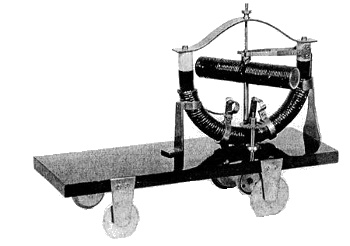Electric Vehicle Radio
April 11, 2012
Nowadays, it's rare when someone listens to
AM radio, but it was the only option a few decades ago. In those days, before ubiquitous
FM radio,
CD players, and
digital music players, it was the only way to hear music while you were driving. No one seemed to notice the
low fidelity, a result of the
bandwidth of such stations being capped by their 10
kHz channel spacing and the bandwidth of the
intermediate frequency (IF) stage in their
superheterodyne receivers. There was also the
noise.
Nature is noisy in an
amplitude-modulated way, so AM radio reception is noisy. The prime example of this is
lightning noise that can be heard during
thunderstorms. In an
automobile with an
internal combustion engine, the
electrical spark ignition will generate noise. This is less of a problem today with
electronic ignition. It was a problem with the older,
mechanical, distributor-type ignition systems, which had a greater density of sparks than a
4th of July celebration in the
US.
Music eventually migrated to the
FM band, where there's more bandwidth and an easy
analog method to broadcast stereophonic signals. FM has the further advantage that
frequency modulated noise is rare. This advantage may disappear with the introduction of
electric vehicles. The high
currents and specific
control circuitry for their
motors can cause significant
electromagnetic interference that includes both amplitude and frequency modulated components.

The First Electric Car?
Electric car of Ányos Jedlik, 1828. Jedlik was an Hungarian inventor, engineer, physicist, Benedictine priest, and a member of the Hungarian Academy of Sciences.
(Via Wikimedia Commons))
Electric vehicles require high power motors. The
Chevy Volt, for example, uses a
three-phase alternating current induction motor rated at more than 100
kilowatt.[1] For comparison, most AM broadcasting stations in the US transmit from 1-5 kW. The speed of such motors is determined by the frequency of the current supply, so variable speed is accomplished by variable frequency.
Even at a fixed frequency, such
variable frequency drive circuitry still delivers its current in
pulses that produce considerable electromagnetic interference. Pulses are rich in
harmonics, and these harmonics cause interference in many frequency bands.
The
Fraunhofer Society has had the fortunate windfall of
MP3 licensing revenue that's fueled much of its research. Starting in 1998, the Society has asserted rights to MP3
digital encoding of signals.[2] This resulted in 100 million
Euros licensing income in 2005, and 69 million Euros in 2006.[3] This income is used by the Fraunhofer Foundation to fund other
patent-oriented research projects. This funding may have directly, or indirectly, helped some recent research on reducing electromagnetic interference in electric vehicles.
The purpose of this research program, led by
Dr. Eckart Hoene, director of the Power Electronic Systems research group at the
Fraunhofer Institute for Reliability and Microintegration IZM in
Berlin, is to eliminate or reduce the
shielding needed for the motor and connecting wires, while at the same time maintaining acceptable levels of radio frequency interference. They are doing this by
computer simulations that analyze the affect of component placement and orientation.[FR]
Says Hoene,
"The size and position of individual components – including the electric motor, the battery, the air-conditioning compressor, the charging system, the DC/DC converter and the frequency converter itself – play a crucial role. How and in what direction cables are installed is just as important, as is the thickness of their insulation."[FR]
All this reminds me of the
vacuum tube days, when signals from the 6.3
volt (rarely, 12.6 volt)
filament supply would introduce 60 Hz hum into
audio amplifiers. The mitigation scheme was to twist the filament cables before connection, so that the
induced currents canceled, keeping these wires well away from sensitive components, and not have other wires run
parallel to filament lines.
Other tactics were to have a
grounded center tap on the
transformer winding that supplied the filament voltage, or wire in a "hum pot." A hum pot was a low
resistance (typically 100
ohm)
potentiometer connected across the filament supply with the wiper attached to ground. Suitable adjustment of this potentiometer would allow
phase cancellation of the spurious hum signal.
Fraunhofer has further redesigned the power module, a component of the voltage converter, in a
symmetrical architecture which will further reduce interference.[FR] The
German researchers point out that such interference problems are not limited to electric vehicles.
Photovoltaic arrays have similar high currents and electronic circuitry, and their placement atop residences would cause interference within.
To hear the radio frequency interference emitted by my LCD monitor at 250 kHz, listen to this
ten second MP3 clip.
References:
- Chevy Volt FAQs, GM-Volt.com.
- Early MP3 Patent Enforcement, ChillingEffects.org.
Muzinée Kistenfeger, The Fraunhofer Society (Fraunhofer-Gesellschaft, FhG), Science and Innovation Factsheet No.5, British Embassy Berlin, July, 2007.
- Listening to the radio even with an electric drive, Fraunhofer Society Research News, April 2, 2012.
Permanent Link to this article
Linked Keywords: AM radio; FM radio; CD player; digital music player; low fidelity; bandwidth; kHz; channel spacing; intermediate frequency; superheterodyne; receiver; noise; nature; amplitude-modulated; lightning; thunderstorm; automobile; internal combustion engine; electrical spark ignition; electronic ignition; mechanical, distributor-type ignition system; Independence Day United States; 4th of July; US; FM band; analog method to broadcast stereophonic signals; frequency modulation; electric vehicle; currents; control circuitry; motor; electromagnetic interference; Ányos Jedlik; Hungarian; inventor; engineer; physicist; Benedictine priest; Hungarian Academy of Sciences; Wikimedia Commons; Chevy Volt; three-phase alternating current induction motor; kilowatt; variable frequency drive circuitry; pulse; harmonic; Fraunhofer Society; MP3; Intellectual property; licensing; codec; digital encoding; Euro; patent; Dr. Eckart Hoene; Fraunhofer Institute for Reliability and Microintegration IZM; Berlin; electromagnetic shielding; computer simulation; vacuum tube; volt; filament; audio amplifier; induced current; paralle; electrical ground; grounded; center tap; transformer; resistance; ohm; potentiometer; phase cancellation; symmetrical; architecture; German; Photovoltaic array.